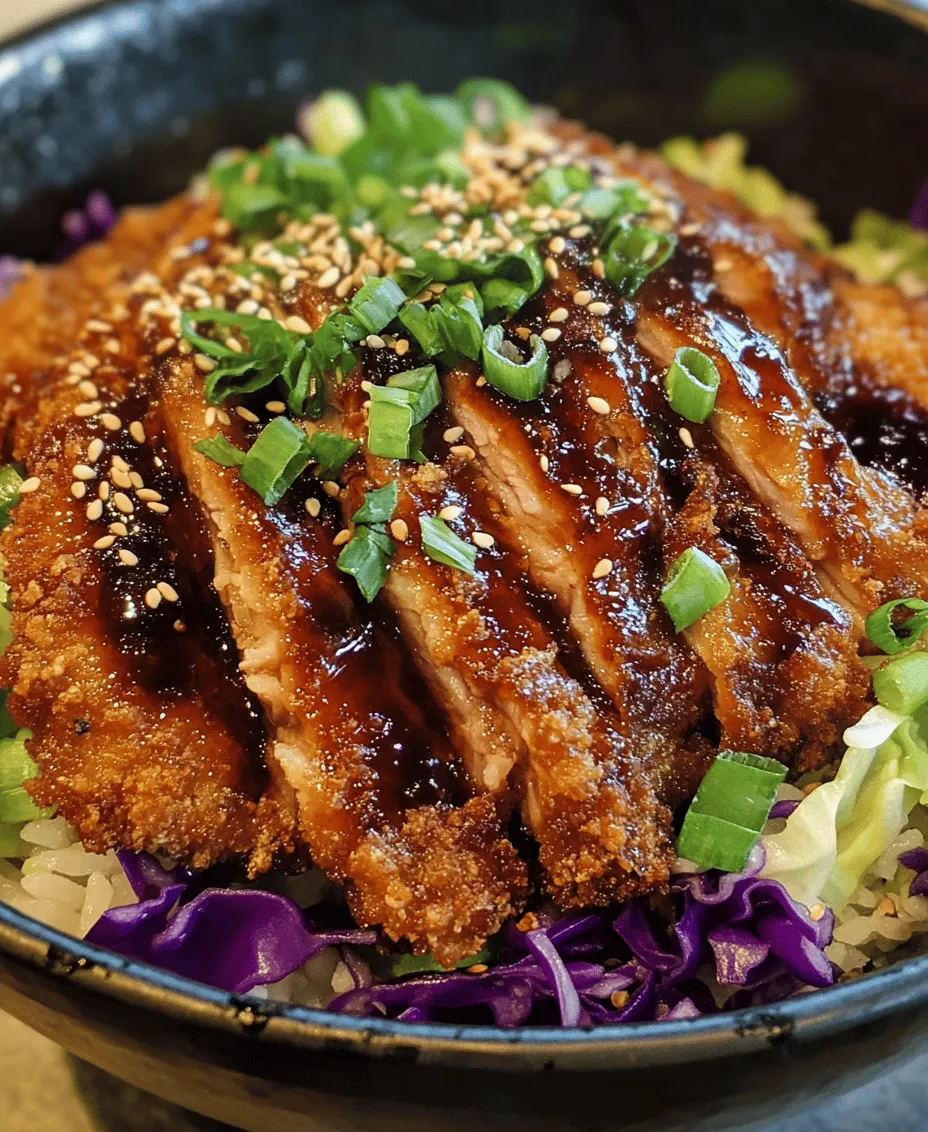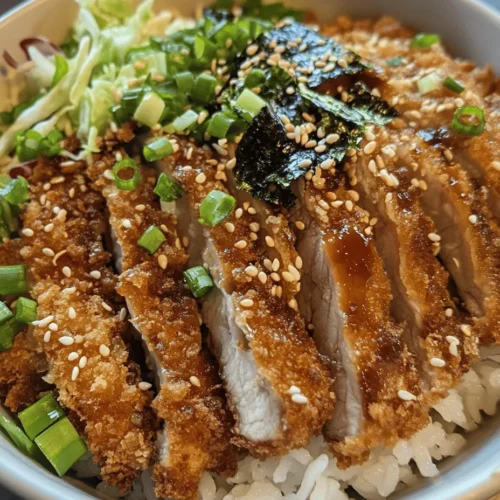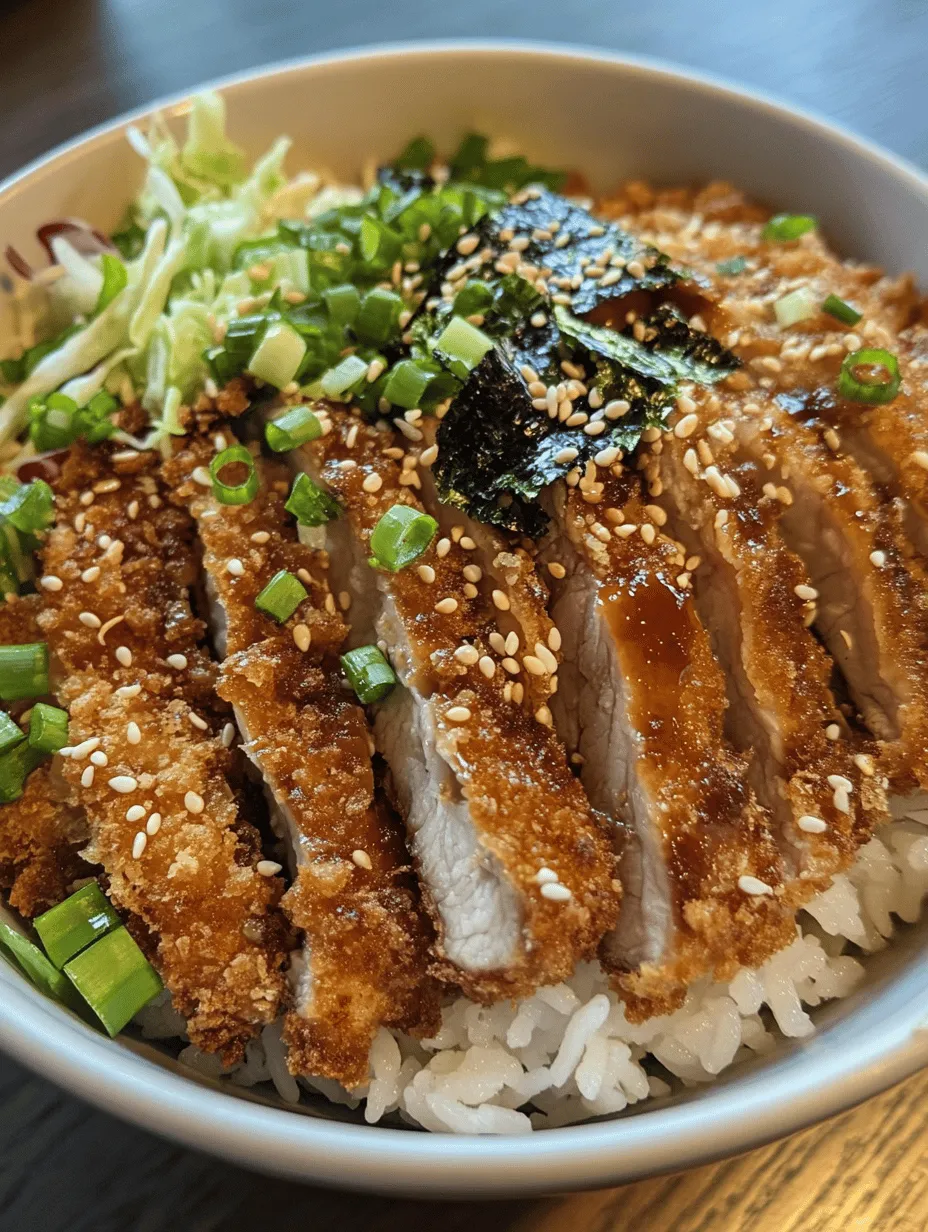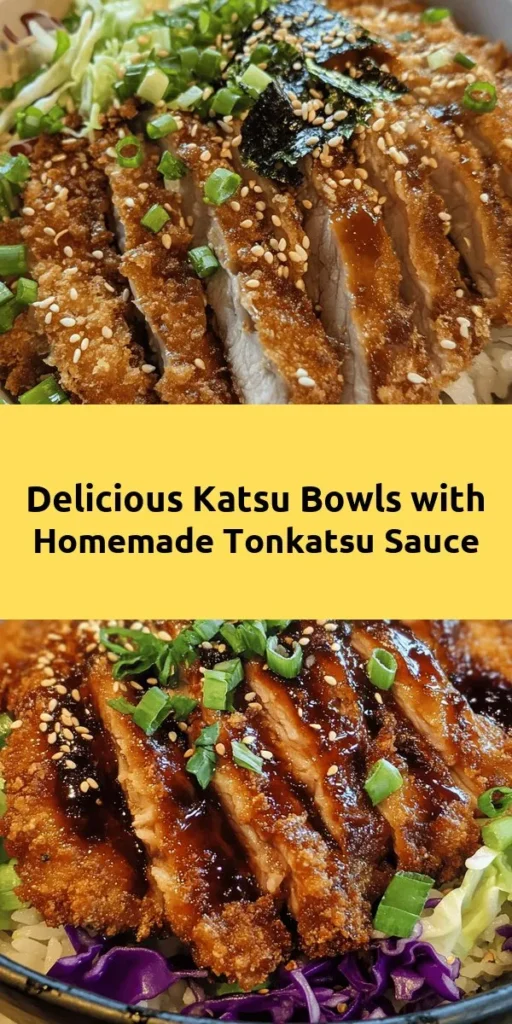Introduction
Japanese cuisine is celebrated globally for its emphasis on fresh ingredients, harmonious flavors, and aesthetic presentation. At its core, Japanese cooking reflects a deep respect for nature and seasonal ingredients, creating dishes that are both nourishing and visually appealing. Among the many delightful offerings of this rich culinary tradition, Katsu bowls stand out as a popular comfort food—a satisfying and hearty meal that has captured the hearts of many.
Katsu bowls, featuring crispy fried meat served over rice and accompanied by a variety of toppings, embody the essence of Japanese home cooking. They are perfect for a cozy dinner or a casual lunch and can be customized with various ingredients to suit individual preferences. The star of the dish is undoubtedly the Tonkatsu sauce, a tangy and umami-rich condiment that elevates the flavor profile of the Katsu. The combination of crispy meat, fluffy rice, and the savory sauce creates an unforgettable dining experience that transports you straight to a bustling izakaya in Japan.
In this article, we will explore the delightful world of Katsu bowls and guide you through the process of making your own savory Japanese Katsu with tangy Tonkatsu sauce. From understanding the cultural significance of Tonkatsu to mastering the art of frying the perfect cutlet, this recipe is sure to impress your family and friends.
Understanding Tonkatsu
Definition of Tonkatsu: Origin and Meaning
Tonkatsu, which translates to “pork cutlet,” is a beloved Japanese dish that consists of a breaded and deep-fried pork cutlet. The origins of Tonkatsu can be traced back to the late 19th century, during the Meiji era, when Western cuisine began to influence Japanese cooking. It is believed that Tonkatsu was inspired by the French dish “cotelettes de porc,” which led to the creation of this delicious cutlet that combines Western frying techniques with traditional Japanese flavors.
The preparation of Tonkatsu involves coating a pork cutlet in flour, dipping it in egg, and then rolling it in panko bread crumbs before deep frying until golden brown. The result is a crispy exterior that contrasts beautifully with the tender, juicy meat inside. Tonkatsu has since evolved into a staple dish in Japanese cuisine, commonly found in homes, restaurants, and even bento boxes.
The Role of Tonkatsu in Japanese Meals
Tonkatsu plays a significant role in Japanese meals, serving as both a main dish and a versatile ingredient. It is often enjoyed with a side of shredded cabbage, rice, and a drizzle of Tonkatsu sauce. The dish is not only filling but also provides a delightful balance of flavors and textures. In addition to being served in bowls, Tonkatsu can also be found in sandwiches, known as “katsu sando,” and as a topping for curry rice.
The cultural importance of Tonkatsu extends beyond its delicious taste; it represents the Japanese philosophy of “umami,” the fifth taste that enhances the overall flavor experience. The savory and rich profile of Tonkatsu makes it a favorite among people of all ages, ensuring its place in the hearts of both locals and visitors to Japan.
Variations of Tonkatsu
While pork is the most common meat used in Tonkatsu, variations exist that cater to different tastes and preferences. Chicken Katsu, made with breaded and fried chicken cutlets, is a popular alternative, especially for those who may not enjoy pork. Additionally, some chefs experiment with other meats such as beef or even tofu for a vegetarian option.
The frying technique also varies, with some recipes calling for shallow frying in a pan while others utilize deep frying for a more indulgent experience. Regardless of the variation, the essence of Tonkatsu remains the same: a crispy, flavorful, and satisfying dish that can be enjoyed in numerous ways.
Ingredients Breakdown
To create your own savory Japanese Katsu bowl with tangy Tonkatsu sauce, you’ll need the following key ingredients:
Boneless Pork Loin Chops
When it comes to selecting the right cut of meat for your Tonkatsu, boneless pork loin chops are the ideal choice. This cut is tender, flavorful, and has the perfect balance of fat to keep the meat juicy during cooking. Look for pork chops that are uniform in thickness (about 1 inch) to ensure even cooking. If you prefer a leaner option, you can also use pork tenderloin, but be aware that it may require careful handling to avoid drying out.
Panko Bread Crumbs
Panko bread crumbs are essential for achieving that signature crunch in your Tonkatsu. Unlike regular bread crumbs, which can lead to a dense coating, panko is made from crustless bread and has a lighter, flakier texture. This unique structure allows for maximum crispiness when fried. If you can’t find panko at your local grocery store, you can make your own by processing crustless white bread in a food processor until it resembles coarse flakes.
Tonkatsu Sauce Components
The magic of Tonkatsu sauce lies in its harmonious blend of flavors. A typical Tonkatsu sauce recipe includes:
– Ketchup: Provides a sweet and tangy base.
– Worcestershire Sauce: Adds depth and umami flavor.
– Mirin: A sweet rice wine that balances the acidity with its sweetness.
– Soy Sauce: Enhances the savory profile and contributes to the dark color of the sauce.
– Sugar: A touch of sugar can be added to increase sweetness and round out the flavors.
These ingredients come together to create a rich and complex sauce that perfectly complements the crispy cutlet. While traditional recipes are delicious on their own, feel free to customize the sauce by adjusting the ratios or adding ingredients like mustard or garlic for an extra kick.
Preparing the Tonkatsu Sauce
Creating your own Tonkatsu sauce at home is simple and rewarding. Follow these steps to make a flavorful sauce that will elevate your Katsu bowls:
1. Gather Your Ingredients: Measure out the ketchup, Worcestershire sauce, mirin, soy sauce, and sugar in a bowl.
2. Mix Well: Combine all the ingredients until they are thoroughly blended. Adjust the sweetness or tanginess by adding more sugar or Worcestershire sauce according to your taste.
3. Let It Rest: Allow the sauce to sit for at least 10-15 minutes to let the flavors meld together. This resting period enhances the overall taste.
4. Store: If you have leftover sauce, store it in an airtight container in the refrigerator for up to a week.
This homemade Tonkatsu sauce is not only delicious but also versatile; it can be used as a dipping sauce for vegetables, drizzled over rice, or even as a marinade for grilled meats.
Cooking the Tonkatsu
Now that you have your Tonkatsu sauce prepared, it’s time to cook the Tonkatsu itself. Follow these detailed instructions to ensure that your pork chops come out perfectly crispy and delicious:
1. Prepare the Pork Chops: Start by patting the boneless pork loin chops dry with paper towels. This step is crucial as it helps the breading adhere better and prevents excess moisture from steaming the meat during frying.
2. Season the Meat: Generously season both sides of the pork chops with salt and pepper. This simple seasoning enhances the natural flavors of the pork and provides a solid base for your dish.
3. Breading Station Setup: Set up a breading station with three shallow dishes: one for flour, one for beaten eggs, and one for panko bread crumbs. This organization will streamline the breading process.
4. Bread the Pork Chops:
– Coat in Flour: Dredge each pork chop in flour, shaking off the excess. The flour helps the egg adhere to the meat.
– Dip in Egg: Next, dip the floured chop into the beaten eggs, ensuring it is completely coated.
– Roll in Panko: Finally, press the chop into the panko bread crumbs, making sure to cover it evenly. Gently press the crumbs onto the surface to create a thick, even coating.
5. Fry the Pork Chops: Heat a generous amount of vegetable oil in a deep frying pan or skillet over medium heat. To test if the oil is hot enough, drop a few panko crumbs into the oil; they should sizzle and float to the surface immediately. Carefully add the breaded pork chops to the oil, making sure not to overcrowd the pan. Fry for about 4-5 minutes on each side or until golden brown and cooked through. The internal temperature should reach 145°F (63°C).
6. Drain and Rest: Once the pork chops are cooked, transfer them to a paper towel-lined plate to drain excess oil. Let them rest for a few minutes before slicing, allowing the juices to redistribute and ensuring a moist cutlet.
With these steps, you will have perfectly cooked Tonkatsu ready to be served over rice and accompanied by your homemade Tonkatsu sauce.
Stay tuned for the next segment, where we will delve into assembling your Katsu bowl and provide tips for the best presentation and serving suggestions!

Step-by-Step Breading Process: Techniques for Achieving a Perfect Crust
To create the signature crispy coating on your Katsu, mastering the breading process is essential. Here’s a detailed guide on how to achieve that perfect crunch.
1. Prepare Your Stations: Set up three shallow dishes for the breading process. The first should contain all-purpose flour seasoned with a pinch of salt and pepper; the second should hold beaten eggs, and the third should be filled with panko breadcrumbs. Panko is crucial for a light and airy crust, so do not substitute with regular breadcrumbs.
2. Coat the Pork: Start with the pork cutlets. Pat them dry with paper towels, as moisture can hinder the breading process. First, dredge each cutlet in the flour mixture, ensuring it’s evenly coated. Shake off any excess flour.
3. Egg Dip: Next, dip the floured cutlet into the beaten eggs, allowing any surplus to drip back into the bowl. This step is vital for allowing the panko to adhere properly.
4. Panko Coating: Finally, press the cutlet into the panko breadcrumbs, ensuring a thorough coating. Gently press down to help the breadcrumbs stick, ensuring all edges are covered for maximum crunch.
5. Rest Before Frying: Once breaded, let the cutlets rest on a wire rack or a plate for about 10-15 minutes. This allows the coating to adhere better during frying, reducing the risk of it falling off.
Temperature Control: Ensuring the Oil is Hot Enough for Frying Without Burning the Breading
The success of your Katsu largely depends on oil temperature. Here’s how to ensure you get it just right:
1. Choose the Right Oil: For frying, opt for oils with high smoke points like vegetable, canola, or peanut oil. These oils can withstand high temperatures without burning.
2. Heat the Oil: In a large skillet or deep fryer, pour enough oil to submerge at least half of the cutlet. Heat the oil over medium-high heat. To check if the oil is ready, drop a few panko crumbs into the oil; if they sizzle and rise to the surface, the oil is hot enough.
3. Maintain Temperature: Once the oil is ready, carefully add the breaded cutlets to the pan. Avoid overcrowding, as this can lower the oil’s temperature. Fry until golden brown, about 3-4 minutes per side. Use a thermometer to maintain a temperature of around 350°F (175°C).
4. Drain Excess Oil: After frying, place the cutlets on a wire rack or paper towels to drain excess oil. This step helps keep the Katsu crispy and prevents it from becoming soggy.
Assembling the Katsu Bowls
Once your Katsu is perfectly fried, it’s time to assemble your bowls for a visually appealing dish.
Aesthetic Considerations: How to Present the Bowl for Maximum Visual Appeal
Presentation can elevate your Katsu bowls from simple to spectacular. Here are some tips:
– Layering: Start with a base of fluffy white rice. Use a scoop or mold to shape it neatly in the center of the bowl.
– Slicing the Katsu: After letting the Katsu rest for a few minutes, slice it into strips. Arrange these elegantly over the rice, fanning them out slightly to showcase the crispy crust.
– Add Color: Incorporate a vibrant pile of shredded cabbage on one side of the bowl. This adds color and provides a refreshing crunch that contrasts beautifully with the tender Katsu.
– Sauce Art: Drizzle the tangy Tonkatsu sauce over the cutlets and rice, and consider adding a small bowl of extra sauce on the side for dipping.
Importance of Texture and Balance in the Dish
A well-balanced Katsu bowl should provide a variety of textures and flavors:
– Crunchy Cabbage: The crispness of the cabbage not only adds freshness but also a satisfying crunch that complements the Katsu’s crunchiness.
– Tender Pork: The juicy, tender pork should be the star of the dish, providing rich flavor and a hearty bite.
– Fluffy Rice: The rice serves as a neutral base, absorbing the delicious sauce and balancing the dish’s richness.
Suggested Garnishes Like Nori and Pickled Ginger for Added Flavor
To enhance the flavors of your Katsu bowls, consider adding the following garnishes:
– Nori: Thin strips of nori (seaweed) can be sprinkled on top for an umami kick and a touch of elegance.
– Pickled Ginger: This adds a tangy bite that complements the richness of the Katsu and helps cleanse the palate.
– Sesame Seeds: Toasted sesame seeds can add a nutty flavor and a bit of crunch.
Serving Suggestions
To round out your Katsu bowl experience, consider these serving suggestions:
Ideal Accompaniments for Katsu Bowls: Side Dishes That Complement the Meal
While Katsu bowls are satisfying on their own, side dishes can enhance the meal:
– Miso Soup: A warm bowl of miso soup is a comforting addition, providing a savory contrast to the Katsu.
– Edamame: Lightly salted edamame makes for a healthy and protein-rich side.
– Japanese Pickles (Tsukemono): These add a refreshing crunch and acidity to balance the meal.
Beverage Pairings to Enhance the Dining Experience
Pair your Katsu bowl with drinks that complement the flavors:
– Green Tea: A classic pairing, the subtle bitterness of green tea works well with the richness of the Katsu.
– Sake: For an authentic experience, serve warm or chilled sake, which can enhance the umami flavors in the dish.
– Japanese Beer: Light and crisp Japanese lagers can cleanse the palate between bites.
Variations to Consider for a More Personalized Twist on the Traditional Recipe
Feel free to experiment with variations of the Katsu bowl to suit your taste:
– Chicken or Tofu Katsu: Substitute pork with chicken breast or tofu for a different protein option.
– Spicy Tonkatsu Sauce: For those who enjoy heat, mix in some sriracha or chili oil into your Tonkatsu sauce.
– Vegetable Katsu: Try breading and frying vegetables such as eggplant or zucchini for a vegetarian-friendly version.
Nutritional Information
Understanding the nutritional aspects of Katsu bowls can help you enjoy them guilt-free.
Overview of the Nutritional Aspects of This Dish
Katsu bowls offer a balanced meal with protein, carbohydrates, and vegetables. A typical serving contains:
– Calories: Approximately 600-800 calories depending on portion sizes.
– Protein: High in protein due to the pork, providing essential amino acids.
– Fiber: The cabbage and rice offer dietary fiber for digestive health.
Balancing Indulgence with Nutritional Value: How to Enjoy Katsu Bowls Without Guilt
While Katsu bowls can be indulgent, there are ways to enjoy them while maintaining nutritional balance:
– Portion Control: Serve smaller portions of Katsu while bulketing the bowl with more vegetables.
– Whole Grain Rice: Substitute white rice with brown rice for added fiber and nutrients.
– Healthier Cooking Methods: Consider baking or air-frying the Katsu for a lower-fat option.
Considerations for Dietary Restrictions or Substitutions
Katsu bowls can be tailored for various dietary needs:
– Gluten-Free: Use gluten-free breadcrumbs and tamari in place of soy sauce.
– Vegetarian/Vegan: As mentioned, tofu or vegetable Katsu can easily replace the pork.
Cultural Context and Significance
Understanding the cultural background of Katsu enhances your appreciation of the dish.
The Role of Katsu in Japanese Culture and Its Evolution Over Time
Katsu, particularly Tonkatsu, originated in the 19th century and has become a beloved staple in Japanese cuisine. It reflects the fusion of Western and Japanese culinary practices, showcasing how tradition can evolve while maintaining its essence.
How Katsu Bowls Have Become Popular Worldwide and Their Adaptation in Different Cuisines
In recent years, Katsu bowls have gained popularity outside Japan, often adapted to local tastes and ingredients. Variations can be found in fusion restaurants, incorporating flavors and styles from various cuisines.
Personal Anecdotes or Stories Related to Katsu Bowls to Create a Connection with the Reader
Many people have fond memories of enjoying Katsu bowls with family or friends, whether at home or in cozy Japanese restaurants. Sharing experiences about the first time tasting Katsu or cooking it for loved ones can create a sense of connection with this dish.
Conclusion
Creating Savory Japanese Katsu Bowls with Tangy Tonkatsu Sauce at home is a rewarding experience that combines rich flavors and delightful textures. The process of breading, frying, and assembling these bowls not only offers a delicious meal but also an opportunity to share a piece of Japanese culture with your family and friends.
As you savor each bite, reflect on the joy of cooking and the connections it fosters. This dish is not just a meal; it is a celebration of culinary creativity and tradition. Dive into the world of Japanese cuisine and continue to explore the vibrant flavors it has to offer. Your kitchen is a canvas, and Katsu bowls are just the beginning of your culinary journey. Enjoy the process and have fun experimenting with new flavors and ingredients along the way!



